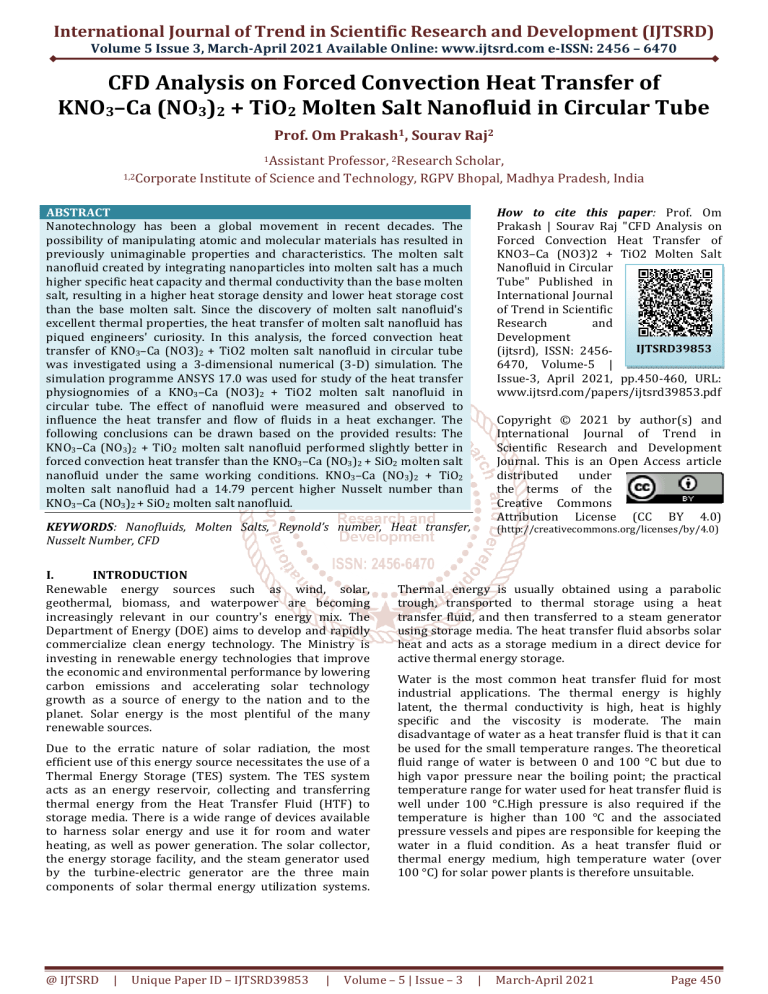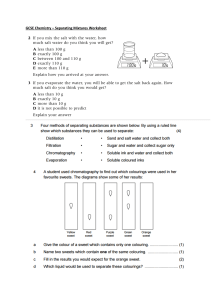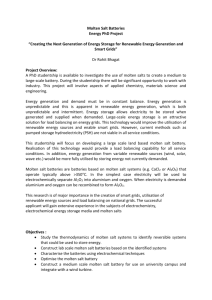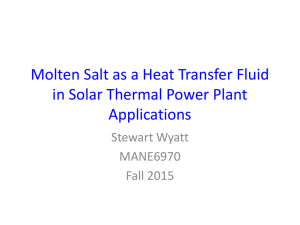
International Journal of Trend in Scientific Research and Development (IJTSRD)
Volume 5 Issue 3, March-April
April 2021 Available Online: www.ijtsrd.com e-ISSN:
e
2456 – 6470
CFD Analysis on Forced Convection Heat Transfer
T
of
KNO3–Ca (NO3)2 + TiO2 Molten Salt Nanofluid
anofluid in Circular Tube
Prof. Om Prakash1, Sourav Raj2
1Assistant
Professor, 2Research Scholar,
1,2Corporate Institute of Science and Technology, RGPV Bhopal, Madhya Pradesh,
Pradesh India
ABSTRACT
Nanotechnology has been a global movement in recent decades. The
possibility of manipulating atomic and molecular materials has resulted in
previously unimaginable properties and characteristics. The molten salt
nanofluid created by integrating nanoparticles into molten salt has a much
higher specific heat capacity and thermal conductivity than the base molten
salt, resulting in a higher heat storage density and lower heat storage cost
than the base molten salt. Since
ince the discovery of molten salt nanofluid's
excellent thermal properties, the heat transfer of molten salt nanofluid has
piqued engineers' curiosity. In this analysis, the forced convection heat
transfer of KNO3–Ca (NO3)2 + TiO2 molten salt nanofluid in circular tube
was investigated using a 3-dimensional
dimensional numerical (3-D)
(3
simulation. The
simulation programme ANSYS 17.0 was used for study of the heat transfer
physiognomies of a KNO3–Ca (NO3)2 + TiO2 molten salt nanofluid in
circular tube. The effect of nanofluid
nofluid were measured and observed to
influence the heat transfer and flow of fluids in a heat exchanger. The
following conclusions can be drawn based on the provided results: The
KNO3–Ca (NO3)2 + TiO2 molten salt nanofluid performed slightly better in
forced
ced convection heat transfer than the KNO3–Ca (NO3)2 + SiO2 molten salt
nanofluid under the same working conditions. KNO3–Ca (NO3)2 + TiO2
molten salt nanofluid had a 14.79 percent higher Nusselt number than
KNO3–Ca (NO3)2 + SiO2 molten salt nanofluid.
How to cite this paper:
paper Prof. Om
Prakash | Sourav Raj "CFD Analysis on
Forced Convection Heat Transfer of
KNO3–Ca
Ca (NO3)2 + TiO2 Molten Salt
Nanofluid in Circular
Tube" Published in
International Journal
of Trend in Scientific
Research
and
Development
IJTSRD39853
(ijtsrd), ISSN: 24562
6470, Volume-5
Volume
|
Issue-3,
3, April 2021, pp.450-460,
pp.450
URL:
www.ijtsrd.com/papers/ijtsrd39853.pdf
KEYWORDS: Nanofluids, Molten Salts, Reynold’s number, Heat transfer,
Nusselt Number, CFD
(http://creativecommons.org/licenses/by/4.0
//creativecommons.org/licenses/by/4.0)
I.
INTRODUCTION
Renewable energy sources such as wind, solar,
geothermal, biomass, and waterpower are becoming
increasingly relevant in our country's energy mix. The
Department of Energy (DOE) aims to develop and rapidly
commercialize clean energy technology. The Ministry is
investing in renewable energy technologies that improve
the economic and environmental performance by lowering
carbon emissions and accelerating solar technology
growth as a source of energy to the nation and to the
planet. Solar energy is the most plentiful of the many
renewable sources.
Due to the erratic nature of solar radiation, the most
efficient use of this energy source necessitates the use of a
Thermal Energy Storagee (TES) system. The TES system
acts as an energy reservoir, collecting and transferring
thermal energy from the Heat Transfer Fluid (HTF) to
storage media. There is a wide range of devices available
to harness solar energy and use it for room and water
heating,
ting, as well as power generation. The solar collector,
the energy storage facility, and the steam generator used
by the turbine-electric
electric generator are the three main
components of solar thermal energy utilization systems.
@ IJTSRD
|
Unique Paper ID – IJTSRD39853
39853
|
Copyright © 2021
20
by author(s) and
International Journal of Trend in
Scientific Research and Development
Journal. This is an Open Access article
distributed
under
the terms of the
Creative Commons
Attribution License (CC BY 4.0)
Thermal energy is usually obtained
obtai
using a parabolic
trough, transported to thermal storage using a heat
transfer fluid, and then transferred to a steam generator
using storage media. The heat transfer fluid absorbs solar
heat and acts as a storage medium in a direct device for
active thermal energy storage.
Water is the most common heat transfer fluid for most
industrial applications. The thermal energy is highly
latent, the thermal conductivity is high, heat is highly
specific and the viscosity is moderate. The main
disadvantage of water
ter as a heat transfer fluid is that it can
be used for the small temperature ranges. The theoretical
fluid range of water is between 0 and 100 °C but due to
high vapor pressure near the boiling point; the practical
temperature range for water used for heat
hea transfer fluid is
well under 100 °C.High pressure is also required if the
temperature is higher than 100 °C and the associated
pressure vessels and pipes are responsible for keeping the
water in a fluid condition. As a heat transfer fluid or
thermal energy
gy medium, high temperature water (over
100 °C) for solar power plants is therefore unsuitable.
Volume – 5 | Issue – 3
|
March-April
April 2021
Page 450
International Journal of Trend in Scientific Research and Development (IJTSRD) @ www.ijtsrd.com eISSN: 2456-6470
Figure 1 Methods for storing solar thermal energy
The use of thermal oils in the thermal storage media or heat transport fluid is possible up to 300°C in its liquid phase, but
there are many intrinsic disadvantages, such as a low decomposition temperature, low density, flammability, high vapor
pressure, a fuming ten dance and a poor chemical stability, which restrict their applications.
applicati
Molten salts are a very unique category with an enormous potential for storage and heat transmission media for solar
energy applications, from the whole range of materials searched for different properties. For high temperatures from 250
°C to 1000 °C, molten salts were suggested as heat transfer fluids. Molten salts are a series of salts that remain liquid over a
large range of temperatures. Other main LMP salts features include strong electrical and heat conductivity, high thermal
and chemical stability,
ity, low viscosity and ecological performance. In the other hand, its low rate of heat transfer decreases
its industrial efficiency. Improved thermo-physical properties (specific heat, cp and thermal conductivity, k) are crucial to
advancing the CSP systemss of TES and current HTFs.
Recent studies have shown that molten salt Nano fluid formed by adding nanoparticles in molten salt may have a
significantly greater basic thermal potential and thermal conductivity than its base molten salt. Research on molten salt
s
Nano-fluid
fluid forced convection heat transfer is therefore insufficient.
II.
LITERATURE REVIEW
Due to their stability at elevated temperatures, low vapor pressures, broad operating temperature ranges, minimal
environmental footprint, ease of materials handling,
handling, low materials costs, and safety, research activities involving molten
salts have gained popularity as working fluids for high temperature processing applications and thermal-fluidics
thermal
applications over the last two decades. Solar power generation, advanced
advanced nuclear reactors, chemical refining, and energy
storage are just some of the uses of molten salts as engineering fluids. Concentrating Solar Power (CSP) plants, in
particular, are gaining prominence around the world.
Given the growing prevalence of molten
en salts in the contemporary research literature, the aim of this analysis is to
elucidate the complexities of experimental heat transfer studies involving molten salts. The aim of this analysis is to
objectively examine the observations in the literature and address their consequences. The aim of this analysis is to define
potential research needs and directions based on discussions and consequences of previous literature findings. As a
consequence, a list of recent developments concerning molten salt mixtures
mixtures or eutectics (including a short overview of
patterns in their thermo-physical
physical properties) is presented.
Recent experimental findings involving forced convection heat transfer for molten salt eutectics are reviewed in this study
with the aim of determining
ning potential research directions and technological needs.
Bin et al. (2009) conducted turbulent convective heat transfer experiments using LiNO3 in a stainless steel concentric
tube. Molten LiNO3 flowing through the inner tube was cooled by flowing mineral
mineral oil through the annulus. The predictions
from Dittus-Boelter
Boelter and Colburn equation were higher than the experimental data, by as much as 25% and 18%,
respectively [1].
Yang et al. (2010) investigated the heat transfer enhancement accruing from using a spiral
spiral tube instead of a smooth tube
for receiver tubes in a Concentrated Solar Power (CSP) plant receiver. A ternary nitrate eutectic of KNO3–NaNO2–NaNO3
(Hitec salt at 53:7:40 by mass fraction) was the working fluid. The authors also used a heated 316L Stainless
Sta
Steel spiral
tube as the test section. The experimental results indicate that the heat transfer performance can be enhanced by as much
as 3 times in a spiral tube, in comparison to that of a smooth tube, for Reynolds number ranging from 15,000 to 55,000
55
[2].
Lu et al. (2013) performed a series of forced convective heat transfer experiments to investigate the efficacy of both
spirally grooved and transversely grooved tubes compared to that of smooth tubes. The working fluid was Hitec salt. The
test section was fabricated using stainless steel tubes. In general, both transverse and spiral grooves enhanced heat
transfer by as much as ~1.4 times and ~1.5 times, respectively (compared to that of smooth tubes) for Reynolds number
ranging from 5000 to 15000 [3].
@ IJTSRD
|
Unique Paper ID – IJTSRD39853
39853
|
Volume – 5 | Issue – 3
|
March-April
April 2021
Page 451
International Journal of Trend in Scientific Research and Development (IJTSRD) @ www.ijtsrd.com eISSN: 2456-6470
Chen et al. (2016) investigated the heat transfer performance of Hitec salt in a salt-to-oil concentric tube heat exchanger
with hot salt flowing through the inner tube being cooled by oil flowing in the outer tube. The Reynolds number on the
molten salt side ranged from 10,000 to 50,000 and the Prandtl number ranged from 11 to 27. The experimental results
indicate the measured heat transfer coefficient on the molten salt side were within ± 7% of the values predicted by the
Gnielinski correlation and within ± 8% from the values predicted by the Sider-Tate correlation in fully turbulent regime
[4].
Du et al. (2017) investigated the heat transfer performance of Hitec salt in transitional flow regime in a shell and tube
heat exchanger with segmented baffles. The molten salt was pumped through the shell side and around the tube bundles
with cooling oil flowing through the tubes. The measured heat transfer coefficient on the molten salt side agreed with
traditional Kern correlation with a maximum deviation of 7.1% [5].
Hu et al. (2017) investigated the natural convection heat transfer of eutectic binary nitrate salt-based Al2O3 molten salt
nanofluids in solar power systems. The result shows that the nanofluids with a 1.0% mass concentration of Al2O3
nanoparticles exhibit the best heat transfer performance [6].
Qian et al. (2017) studied the heat transfer performance of Hitec salt in a gas cooled shell and tube heat exchanger
(finned tubes) with salt flowing internally through the tubes. The tests ranged from laminar flow to transition flow
regimes (Reynolds number ranged from 987 to 12,000) and Prandtl number ranged from 9.8 to 18.9. The experimental
data for Nusselt number was found to be within ± 15% of the predicted values [7].
To enhance the heat transfer performance, Chen et al. (2018) modified the experimental apparatus of (Chen et al., 2016)
by replacing the inner tube with a transversely grooved tube. The hot salt flowing through the transversely grooved inner
tube was cooled by oil flowing through the outer tube. The Reynolds number on the salt side ranged from 300 to 60,000
and Prandtl number ranged from 11 to 27. The authors reported 60% enhancement in the values of the heat transfer for
the grooved tubes compared to that of the smooth tubes. However, measurements were not performed for determining
the level of increase in pumping power due to the introduction of the grooves [8].
He et al. (2019) performed experiments to investigate the heat transfer performance of Hitec salt in a shell-and-tube heat
exchanger without baffles. These experiments were performed by varying the inlet temperatures and flow velocities. The
molten salt was pumped in the shell (i.e., external to the tube bundle) with effective Reynolds number ranging from 400 to
2300. Preheated water was pumped through the seven tubes. The measured values of Nusselt number on the molten salt
side ranged from 20 to 100 based on the hydraulic diameter of the flow channel (which is computed based on the area of
cross-section and the wetted perimeter).The experimental heat transfer coefficient on the molten salt side was found to be
3–5 times of the values predicted from the Sider-Tate correlation. The heat transfer enhancement was attributed to the
thin developing boundary layer due to the tube bundle structure in the shell side [9].
Hu Chen et al. (2020) the forced convection heat transfer experiments were carried out in a circular tube of a previously
reported promising molten salt nanofluid composed of KNO3–Ca (NO3)2 + 1 wt% of 20 nm SiO2 nanoparticles (K-C-Snm).
Results showed that compared with its base pure molten salt, the K-C-Snm molten salt nanofluid exhibited substantially
better forced convection heat transfer performance under the same working condition. The Nusselt number and the
convective heat transfer coefficient of K-C-Snm molten salt nanofluid were 16.3% and 39.9% higher than its base pure
molten salt, respectively [10].
Although the aforementioned researchers have researched different aspects of molten salts, there has been no study on
forced convection heat transfer of molten salt nanofluid. However, such research is needed for the successful application of
molten salt nanofluid in industrial practice. The forced convection heat transfer of molten salt nanofluid was numerically
explored in this work.
III.
GEOMETRY SETUP AND MODELLING
In this analysis, the forced convection heat transfer of KNO3–Ca (NO3)2 + TiO2 molten salt nanofluid in circular tube was
investigated using a 3-dimensional numerical (3-D) simulation. The simulation programme ANSYS 17.0 was used for study
of the heat transfer physiognomies of a KNO3–Ca (NO3)2 + TiO2 molten salt nanofluid in circular tube.
The geometry for performing simulation analysis is taken from Hu Chen et al. (2020), a research scholar. Fig. 5.1 presents
the schematic of the experimental system; a molten salt nanofluid circulation loop and a heat conduction oil circulation
loop make up the majority of the system. The heat is transferred from molten salt nanofluid to heat conduction oil through
a circular tube style heat exchanger in this experimental method.The design of the heat exchanger is shown in Fig. 5.2. The
length of the heat exchanger tube L is 100 cm. The outer diameter doand inner diameter diof the heat exchange tube are 3.4
cm and 2 cm, respectively. The inner cross sectional area of the heat exchanger tube Ai is 3 cm2, and the outer cross
sectional area of the heat exchanger tube Ao is 9 cm2. Molten salt is drained from a high-temperature tank, flows through a
heat exchanger, and then flows back to the tank after going through a flow meter in the molten salt distribution loop. The
oil is pumped from a constant temperature oil tank, passes through the heat exchanger, and then flows back into the oil
tank after going through a radiator and a flow meter in the heat conduction oil-circulating loop.
@ IJTSRD
|
Unique Paper ID – IJTSRD39853
|
Volume – 5 | Issue – 3
|
March-April 2021
Page 452
International Journal of Trend in Scientific Research and Development (IJTSRD) @ www.ijtsrd.com eISSN: 2456-6470
Figure 2 Computational model of heat exchanger
A three-dimensional discretized model was built in the pre-processor phase of ANSYS FLUENT R 17.0. Although the grid
types are related to simulation results, the structure as a whole is, by necessity, discrete in the final volume; the
programme ANSYS produces a coarse mesh. Mesh comprises unit-size mixed cells (ICEM Tetrahedral cells) with triangular
frontier faces. In this analysis, a mesh metric is used with a medium fluid curvature.
Figure 3 Meshing of heat exchanger
Table 1 Meshing detail of model
S. No.
Parameters
1
Curvature
On
2
Smooth
Medium
3
Number of nodes
468775
4
Number of elements
1538922
5
Mesh metric
None
6
Meshing type
Tetrahedral
The Fluent 17.0 was used to calculate computationally. In research, the approach used to differentiate the governing
equations was a finite element. For this convective term, the researchers used a simpler algorithm, and for connecting
calculations of the pressure and velocity the second order upwind method was implemented.
A standard k-epsilon equation was used with flow and energy equations to solve turbulence.
Which implies the following hypotheses:
1. There is negligence of thermal radiation and normal convection;
2. The average of fluid and solid properties is calculated
3. Flow is incompressible;
4. Heat transfer steady state;
5. Transitional fluid flow and turbulent regimes, and
6. The fluid is distributed uniformly between the channels and the inlet channels have a uniform velocity profile.
@ IJTSRD
|
Unique Paper ID – IJTSRD39853
|
Volume – 5 | Issue – 3
|
March-April 2021
Page 453
International Journal of Trend in Scientific Research and Development (IJTSRD) @ www.ijtsrd.com eISSN: 2456-6470
The numerical simulation was with a 3-Dimensional steady state turbulent flow system. In order to solve the problem,
governing equations for the flow and conjugate transfer of heat were customized according to the conditions of the
simulation setup. The governing equations for mass, momentum, energy, turbulent kinetic energy and turbulent energy
dissipation are expressed as follow,
Mass:
=0
Momentum:
=
−
Energy Equation:
=
Table 2 Thermodynamic Properties of Binary Salt and Nano-particles
Input Parameters
Symbols
Units
Binary Salt SiO2 TiO2
Specific heat capacity
cp
J/kg-K
1.497
680 686.2
3
ρ
Density
(kg/m )
1.835
2220 4250
Thermal conductivity
k
W/m-K
0.55
1.3
8.593
Here the effective properties of the SiO2/Molten Salt and TiO2/Molten Salt nanofluid are defined as follows:
Pak and cho [11], Patel [12] and Ebrahmnia- Bajestan [29] suggested the below equations for determining density,
thermal conductivity, specific heat and viscosity of nanofluids.
=∅
+ 1−∅
= 1−∅
+2
+2
=
=
1−∅
− 2∅
+∅
+∅
−
−
!.#
Table 3 Thermodynamic Properties of KNO3–Ca(NO3)2 + 1 wt% of 20 nm SiO2 and KNO3–Ca(NO3)2 + 1 wt % of 20
nm TiO2 nanoparticles
Input Parameters
Symbols
Units
Specific heat capacity
Density
Thermal conductivity
cp
ρ
k
J/kg-K
(kg/m3)
W/m-K
KNO3–Ca(NO3)2 + 1
wt % of 20 nm SiO2
628.694
24.016
0.555
KNO3–Ca(NO3)2 + 1
wt % of 20 nm TiO2
658.1323
44.31665
0.5638
The discrete flow domain has been defined under sufficient limits. Inlets were allocated the mass flow rate requirements,
while pressure outlet limits were allocated for outlets. The surfaces of the heat exchanger is regarded as normal wall
limits. The interior walls were fitted with couplings of thermal walls.
Table 4 Details of boundary conditions
Detail
Value
Molten salt nanofluid flow rate
At different Reynold’s no. 15000, 25000, and 35000
Heat conduction oil flow rate
0.465 kg/s
Molten salt nanofluid inlet temperature
300 °C
Heat conduction oil inlet temperature
125 °C
Outer surfaces
Heat flux=0
IV.
RESULTS AND DISCUSSIONS
This section is aimed at evaluating the heat exchanger thermal performance using nanofluids. The variations in the Heat
transfer rate and Thermal conductance are measured at different Reynold’s number in order to research the performance
of the heat exchanger using nanofluids subject to flow.
4.1. Data reduction equations
The values of Nusselt number, and Heat transfer coefficient calculated from the CFD modeling On the basis of temperature
of hot and cold fluid obtained were compared with the values obtained from the analysis performed by Hu Chen et al.
(2020).
The data reduction of the measured results is summarized in the following procedures:
@ IJTSRD
|
Unique Paper ID – IJTSRD39853
|
Volume – 5 | Issue – 3
|
March-April 2021
Page 454
International Journal of Trend in Scientific Research and Development (IJTSRD) @ www.ijtsrd.com eISSN: 2456-6470
The Reynolds number is given by,
&'(
$% =
)
The mass flow rate is calculate on the basis of below formula,
*+ = +&,'
Where, & is the density of fluid, , is the cross sectional area of the pipe and' is the velocity of fluid.
Therefore, for fluid flows in a concentric tube heat exchanger, the heat transfer rate of the hot fluid in the outer tube can be
expressed as:
-. = *+. /0. 1.2 − 1.3
Where *+. is the mass flow rate of hot fluid, /0. is the specific heat of hot fluid, 1.2 and 1.3 are the inlet and outlet
temperatures of hot fluid, respectively.
While, the heat transfer rate of the cold fluid in the inner tube can be expressed as:
-/ = *+/ /0/ 1/3 − 1/2
Average heat transfer rate is given by:
4567 =
-. + -/
= 9,:*
8
Where, :* =
:; <:8
8
:* is the logarithmic mean temperature difference.
9is the overall heat transfer coefficient.
Calculation of Nusselt Number,
=> =
?
$% − ;@@@ AB
8
8
? @.D
; + ;8. C
ABE − ;
8
Where,? = F;. DG HI $% − E. G8J<8
)/0
AB =
K
? → MNOP OQR MSP QN
=> → T UUVW R XYVN
AB → ZNSR[ W R XYVN
4.2. Validation of numerical computations
To validate the accuracy of developed numerical approach, comparison was made with the work reported in Hu Chen et
al. (2020). The heat exchanger geometry that used for validation of numerical computations was considered as same as
the geometry shown in Fig.3.
Figure 4 Temperature contour at Re = 15000 for heat exchanger using KNO3–Ca (NO3)2 + SiO2 molten salt
nanofluid in a circular tube
@ IJTSRD
|
Unique Paper ID – IJTSRD39853
|
Volume – 5 | Issue – 3
|
March-April 2021
Page 455
International Journal of Trend in Scientific Research and Development (IJTSRD) @ www.ijtsrd.com eISSN: 2456-6470
Figure 5 Pressure contour at Re = 15000 for heat exchanger using KNO3–Ca (NO3)2 + SiO2 molten salt nanofluid in
a circular tube.
Figure 6 Velocity contour at Re = 15000 for heat exchanger using KNO3–Ca (NO3)2 + SiO2 molten salt nanofluid in a
circular tube
240
Nusselt number
220
200
180
160
140
120
15000
25000
35000
Reynold's number
Base Paper
Present Study
Figure 7 Values of Nusselt number calculated from the CFD modeling compared with the values obtained from the
analysis performed by Hu Chen et al. (2020) for heat exchanger
@ IJTSRD
|
Unique Paper ID – IJTSRD39853
|
Volume – 5 | Issue – 3
|
March-April 2021
Page 456
Heat Transfer
Coefficient (in W/m2-K)
International Journal of Trend in Scientific Research and Development (IJTSRD) @ www.ijtsrd.com eISSN: 2456-6470
8500
8000
7500
7000
6500
6000
5500
5000
4500
4000
15000
25000
35000
Reynold's number
Base Paper
Present Study
Figure 8 Values of Heat transfer coefficient calculated from the CFD modeling compared with the values obtained
from the analysis performed by Hu Chen et al. (2020) for heat exchanger
From the above graph, it is found that the value of Nu number and heat transfer coefficient calculated from numerical
analysis is closer to value of Nu number and heat transfer coefficient obtained from the base paper, which means that
numerical model of heat exchanger using nanofluid, is correct. There is much lesser difference between experimental and
numerical values.
4.3. Effect of suspension of TiO2 Nano-particles in the molten salt
From the numerical results and experimental data, it is seen that variation tendencies in the values of Nusselt number and
heat transfer coefficient are qualitatively consistent. Therefore, to analyzing the effect of suspension of TiO2Nano-particles
in the molten salt to enhance thermal augmentation, we take volume concentration of 1 %. The boundary conditions were
same as considered during the analysis of heat exchanger. The thermal properties of Nano fluids is mention in chapter 5,
for calculating the effect of different Nano particles on Nusselt number, and heat transfer coefficient.
For Re = 15000
Figure 9 Temperature contour at Re = 15000 for heat exchanger using KNO3–Ca (NO3)2 + TiO2 molten salt
nanofluid in a circular tube.
@ IJTSRD
|
Unique Paper ID – IJTSRD39853
|
Volume – 5 | Issue – 3
|
March-April 2021
Page 457
International Journal of Trend in Scientific Research and Development (IJTSRD) @ www.ijtsrd.com eISSN: 2456-6470
For Re = 25000
Figure 10 Temperature contour at Re = 25000 for heat exchanger using KNO3–Ca (NO3)2 + TiO2 molten salt
nanofluid in a circular tube
For Re = 35000
Figure 11. Temperature contour at Re = 35000 for heat exchanger using KNO3–Ca (NO3)2 + TiO2 molten salt
nanofluid in a circular tube.
@ IJTSRD
|
Unique Paper ID – IJTSRD39853
|
Volume – 5 | Issue – 3
|
March-April 2021
Page 458
International Journal of Trend in Scientific Research and Development (IJTSRD) @ www.ijtsrd.com eISSN: 2456-6470
Comparison between Nanofluid fluid i.e. SiO2/Molten Salt and TiO2/Molten salt at different Reynold’s
number
Nusselt number
4.4.
270
220
170
120
15000
25000
35000
Reynold's number
KNO3–Ca (NO3)2 + SiO2
(Previous work)
KNO3–Ca (NO3)2 + TiO2
(Present work)
Heat Transfer
Coefficient (in W/m2K)
Figure 12 Nusselt number values comparison for Nanofluid fluid i.e. SiO2/Molten Salt and TiO2/Molten salt at
different Reynold’s number
10000
9000
8000
7000
6000
5000
4000
15000
25000
35000
Reynold's number
KNO3–Ca (NO3)2 + SiO2
(Previous work)
KNO3–Ca (NO3)2 + TiO2
(Present work)
Figure 13 Heat transfer coefficient values comparison for Nanofluid fluid i.e. SiO2/Molten Salt and TiO2/Molten
salt at different Reynold’s number
V.
CONCLUSIONS
This CFD research explores the thermal characteristics of
KNO3–Ca (NO3)2+ TiO2 molten salt nanofluid in circular
tube. A strong agreement has been seen in the comparison
of the findings of this research with the existing
experimental results of the literature. The effect of
nanofluid were measured and observed to influence the
heat transfer and flow of fluids in a heat exchanger. The
following conclusions can be drawn based on the provided
results:
The KNO3–Ca (NO3)2 + TiO2 molten salt nanofluid
performed slightly better in forced convection heat
transfer than the KNO3–Ca (NO3)2 + SiO2 molten salt
nanofluid under the same working conditions.
KNO3–Ca (NO3)2 + TiO2 molten salt nanofluid had a
14.79 percent higher Nusselt number than KNO3–Ca
(NO3)2 + SiO2 molten salt nanofluid.
@ IJTSRD
|
Unique Paper ID – IJTSRD39853
|
KNO3–Ca (NO3)2 + TiO2 molten salt nanofluid had a
7.880 percent higher heat transfer coefficient than
KNO3–Ca (NO3)2 + SiO2 molten salt nanofluid.
REFERENCES
[1] Bin, L., Yu-Ting, W., Chong-fang, M., Meng, Y., Hang,
G., 2009. Turbulent convective heat transfer with
molten salt in a circular pipe. Int. Commun. Heat
Mass Transf. 36, 912–916.
[2]
Yang, M., Yang, X., Yang, X., Ding, J., 2010. Heat
transfer enhancement and performance of the
molten salt receiver of a solar power tower. Appl.
Energy 87, 2808–2811.
[3]
Lu, J., He, S., Ding, J., Yang, J., Liang, J., 2013.
Convective heat transfer of high temperature molten
salt in a vertical annular duct with cooled wall. Appl.
Therm. Eng. 73, 1519–1524.
Volume – 5 | Issue – 3
|
March-April 2021
Page 459
International Journal of Trend in Scientific Research and Development (IJTSRD) @ www.ijtsrd.com eISSN: 2456-6470
[4]
[5]
[6]
Chen, Y. S., Wang, Y., Zhnag, J. H., Yuan, X. F., Tian, J.,
Tang, Z. F., Zhu, H. H., Fu, Y., Wang, N. X., 2016.
Convective heat transfer characteristics in the
turbulent region of molten salt in concentric tube.
Appl. Therm. Eng. 98, 213–219.
Du, B. -C., He, Y. -L., Wang, K., Zhu, H. -H., 2017.
Convective heat transfer of molten salt in the shelland-tube heat exchanger with segmental baffles. Int.
J. Heat Mass Transf. 113, 456–465.
Yanwei Hu, Yurong He, Zhenduo ZhangBaocheng
Jiang, Yimin Huang., 2017. Natural convection heat
transfer for eutectic binary nitrate salt based Al2O3
nanocomposites in solar power systems. Renewable
Energy Volume 114, Part B, December 2017, Pages
686-696.
[7]
Qian, J., Kong, Q. -L., Zhang, H. W., Zhu, Z. H., Huan, W.
G., Li, W. H., 2017. Experimental study of shell-andtube molten salt heat exchangers. Appl. Therm. Eng.
616–623.
[8]
Chen, Y. S., Tian, J., Tang, Z. F., Zhu, H. H., Wang, N. X.,
2018. Experimental study of heat transfer
enhancement for molten salt with transversely
grooved tube heat exchanger in laminar-transitionturbulent regimes. Appl. Therm. Eng. 132, 95–101.
[9]
He, S., Lu, J., Ding, J., Yu, T., Yuan, Y., 2014. Convective
heat transfer of molten salt outise the tube bundle of
heat exchanger. Exp. Therm Fluid Sci. 59, 9–14.
[10]
Hu Chena, Xia Chen, Yu-ting Wu, Yuan-wei Lu, Xin
Wang, Chong-fang Ma, 2020. Experimental study on
forced convection heat transfer of KNO3–Ca (NO3)2
+ SiO2 molten salt nanofluid in circular tube. Solar
Energy 206 (2020) 900–906.
[11]
B. C. Pak, Y. L. Cho, Hydrodynamic and heat transfer
study of Dispersed fluids with submicron metallic
oxide particles, Exp. Heat Transf. 11 (1998) 151–
170.
[12]
H. E. Patel, K. B. Anoop, T. Sundararajan, Sarit K. Das,
Model for thermal conductivity of CNT – nanofluids,
Bull. Mater. Sci. 31 (3) (2008) 387–390.
[13]
“Oak Ridge National Laboratory: Molten Salt
Reactor,”
[Online].
Available:
https://www.ornl.gov/msr.
[14]
“Office of Energy Efficiency and Renewable Energy:
Department of Energy,” [Online]. Available:
https://www.energy.gov/eere.
[15]
Petukhov, B. S., 1970. Heat transfer and friction in
turbulent pipe flow with variable physical
properties. Adv. Heat Transf. 6, 503–564.
[16]
Qian, J., Kong, Q. -L., Zhang, H. W., Zhu, Z. H., Huan, W.
G., Li, W. H., 2017. Experimental study of shell-and-
@ IJTSRD
|
Unique Paper ID – IJTSRD39853
|
tube molten salt heat exchangers. Appl. Therm. Eng.
616–623.
[17]
Qiu, Y., Li, M. -J., Wang, W. -Q., Du, B. -C., Wang, K.,
2018. An experimental study on the heat transfer
performance of a prototype molten-salt rod baffle
heat exchanger for concentrated solar power.
Energy 156, 63–72.
[18]
Satoh, T., Yuki, K., Chiba, S. -Y., Hashizume, H.,
Sagara, A., 2017. Heat transfer performance for high
prnadtl and high temperature molten slat flow in
sphere-packed pipes. Fusion Sci. Technol. 52 (3),
618–624.
[19]
Serrano-Lopez, R., Fradera, J., Cuesta-Lopez, S., 2013.
Molten salts database for energy applications. Chem.
Eng. Process. Process Intensif. 73, 87–102.
[20]
Sieder, E. N., Tate, G. E., 1936. Heat transfer and
pressure drop of liquids in tubes. Ind. Eng. Chem. 28,
1429–1435.
[21]
Silverman, M. D., Huntley, W. R., Robertson, H. E.,
1976. Heat transfer measurements in a forced
convective loop with two molten flouride salts: LiFBeF2-ThF2-UF4 and eutectic NaBF4-NaF. ORNL
5335.
[22]
Smirnov, M., Khoklov, V. A., Filatov, E. S., 1987.
Thermal Conductivity of Molten Alkali Halides and
their mixtures. Electrochim. Acta 32 (7), 1019–1026.
[23]
Sohal, m. S., Ebner, A. M., Sabharwall, P., Sharpe, P.
“Engineering Database of Liquid salt Thermo
physical and Thermo chemical Properties,” Idaho
National Laboratory, 2013.
[24]
Wu, Y. -T., Chen, C., Liu, B., Ma, C. F., 2012.
Investigation on forced convective heat transfer of
molten salts in circular tubes. Int. Commun. Heat
Mass Transf. 39, 1550–1555.
[25]
Wu, Y. -T., Liu, S. -W., Xiong, Y. -X., Ma, C. -F., Ding, Y. L., 2015. Experimental study on the heat transfer
characteristics of a low melting point salt in a
parabolic trough solar collector system. Appl.
Therm. Eng. 89, 748–754.
[26]
Xiao, P., Guo, L., Zhang, X., 2015. Investigations on
heat transfer characteristic of molten salt flow in a
helical annular duct. Appl. Therm. Eng. 88, 22–32.
[27]
Yang, M., Yang, X., Yang, X., Ding, J., 2010. Heat
transfer enhancement and performance of the
molten salt receiver of a solar power tower. Appl.
Energy 87, 2808–2811.
[28]
Yu-Ting, W., Bin, L., Chong-Fang, M., Hang, G., 2009.
Convective heat transfer in the laminar-turbulent
transition region with molten salt in a circular tube.
Exp. Therm Fluid Sci. 33, 1128–1132.
Volume – 5 | Issue – 3
|
March-April 2021
Page 460






